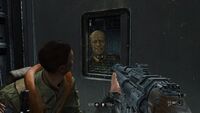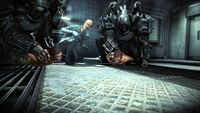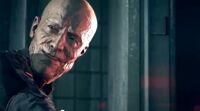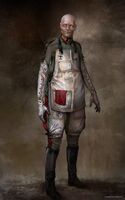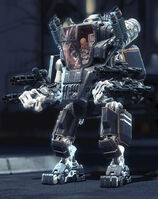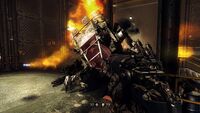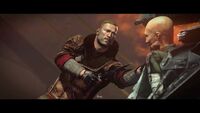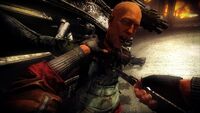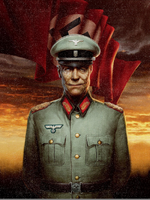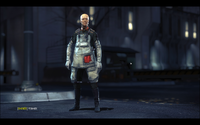- "Captain Blazkowicz. I've heard a lot about you. We have the same name, you and I. Wilhelm, William. But...You call me "Deathshead". I don't like it. I'm a happy man, you see? It doesn't sound right in English. Say it...correctly. Toten...kopf."
- ―Deathshead in Blazkowicz's flashback.[src]
Oberst-Gruppenführer Wilhelm "Deathshead" (Totenkopf) Strasse was one of the most important figures in Nazi Germany: A gifted researcher, technologist, and doctor who headed the SS Special Projects Division and later occupied the post of Minister of Advanced Science. He serves as the main antagonist of Wolfenstein: The New Order.
He is the arch-nemesis of the series' protagonist William J. Blazkowicz and one of the only characters brought over from the earlier Activision series games (see Wilhelm Strasse (Classic)) in the MachineGames reboot. While the game makes a number of references to events from Return to Castle Wolfenstein and Wolfenstein from 2009, they are mostly nods with little bearing on the story or setting.
Deathshead is voiced by former television star Dwight Schultz, best known for playing Captain H.M "Howling Mad" Murdock in the television series "The A-Team".
Background[]
General Wilhelm Strasse is a native of Germany, born in 1860. A scientific genius and devoted researcher, Strasse combines his intellectual acumen with an absolute lack of anything resembling traditional morality. He is a firm believer in German superiority and the imposition of its order upon the world by any means necessary. Little is known of his life prior to Hitler's rise to power. What is known is that Strasse caught the eye of someone powerful and was put in a position to harness his talents for the benefit of the Nazi war machine, especially after the invasion of Poland in 1939. Although his career was endangered on at least two separate occasions, primarily by Captain William J. Blazkowicz, when he infiltrated the X-Labs to dismantle Strasse's first super-soldier project[2][3] and crashed a zeppelin with Strasse onboard, the near-death experiences only provided him with a new outlook on life.
Nicknamed Totenkopf or Deathshead, Strasse committed himself to research with renewed fervor, focusing on Jewish artifacts such as Da'at Yichud. Utterly pragmatic, Strasse saw beyond the Nazis' primitive anti-Semitism, harnessing the incredible technology for the benefit of the regime and to the detriment of the world-- new technology which, by 1944, gave the Nazi war machine the edge it needed to win the war and force the world into submission, repulsing the Allied landings in Normandy, capturing or killing 156,000 soldiers while losing less than a hundred, and allowed Germany to defeat the Red Army at Stalingrad and break the RAF's back at Liverpool in 1945, as he neared his 85th birthday.
The New Order[]
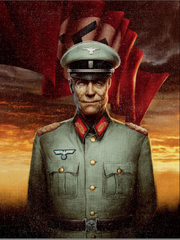
Wilhelm Strasse's portrait in the uniform of a Heer Generalmajor in Wolfenstein: The New Order.
By 1946, Strasse became an essential and indispensable element of the Nazi war machine. Dramatic reversals on all fronts have turned the Allies from predators into prey, and Strasse into the lynchpin of its renewed campaign of conquest. As a Major General of the Wehrmacht and one of the top members of the SS-Hauptamt (Main Office),[4] Deathshead’s headquarters on the Baltic Coast turned into the effective nerve center of the Nazi empire. Believing that the only possible way to reverse the tide was assassination, the Allies authorized a desperate operation to locate and kill Strasse.
Following a nearly disastrous undercover operation focusing on Helga von Schabbs' documents, the Allied forces and OSA Command managed to pinpoint the location of Strasse's fortress. Pooling their surviving warplanes and transports, the Allies launched a massive airborne attack on the Baltic fortress, spearheaded by Royal Marines, British commandos, and whatever surviving Allied assets were still available in Europe - including Captain Blazkowicz himself. The July 16 attack runs into the latest Nazi jet fighters, the Baltisches Auge, and hardened SS troops. Most planes, soldiers, and materiel are lost in the approach, with only a small team under Blazkowicz managing to penetrate the castle.
After an accidental fall into an incinerator, Blazkowicz's squad is captured by Deathshead and his newest, autonomous super soldiers. Deathshead forces Blazkowicz to sacrifice either Private Probst Wyatt III or Wing Commander Fergus Reid, in order to obtain samples for further research. After pulling out their eyes and removing their brain, Strasse orders a super soldier to stand guard, while he sets the incinerator room to a self-cleaning cycle that would remove all trace of the Allies' last attack. Although the incinerator explodes, Strasse remains unaware that some Allied troops survive - including B.J.
- ""So... Gullible""
- ―Deathshead to B.J. before his death.[src]
After World War II (Around 1949-1960), Deathshead has become a revered figure within the Reich and one of the most powerful and influential figures in the Nazi regime, thanks to his role in their victory. He sidelines the paranoid, decrepit Hitler with ease. His advanced technologies, intense focus, and single-minded pursuit of order and perfection have left his centenarian mind as sharp and focused as ever. Strasse's research has pushed the technological boundaries of what was considered possible, resulting in incredible technologies and the colonization of the Moon and Venus.
Although he holds the post of Minister of Advanced Science and remains a prominent figure in the SS, Strasse remains out of the public's eye, utterly disinterested in fostering a cult of personality. His Baltic fortress has expanded tremendously, remade in the image of cold concrete and steel, embodying his ideals of perfection and absolute reason. Though he remains a borderline hermit, Strasse takes a keen interest in the renewed operations of the Kreisau Circle, and eventually deduces the location of their hideout in Berlin. Under his orders, the SS storms the hideout and captures several key members of the resistance, including Anya Oliwa, who are brought to his fortress for interrogation and processing.
Strasse miscalculates for the first time. The Kreisau Circle under Blazkowicz strikes against his Baltic fortress, using a Da'at Yichud weapon to pave the way for Blazkowicz's second attempt at killing Strasse. Deathshead confronts his long time nemesis atop his fortress with a disturbing revelation: He had been preserving the brain of Blazkowicz's teammate he vivisected years ago. He promptly adds the brain to a Prototype Robot he was working on, the ultimate evolution of his super soldier program, and unleashes it on Blazkowicz. When the robot fails and the brain is destroyed, Deathshead decides to confront Blazkowicz himself in a mechanical suit. Despite the odds, B.J. manages to defeat the monstrosity and confront Deathshead.
However, he makes a mistake. Rather than shoot or kill him on the spot, B.J. stabs Strasse several times, giving the Nazi scientist enough time to pull the pin on an antique grenade and blow himself up. Though grievously wounded, Blazkowicz manages to survive long enough to give the order to nuke the castle and remove all traces of Strasse from existence. Fortunately for the world, the Resistance delays long enough to allow a small rescue team to recover B.J. and evacuate him.
Legacy[]
With Strasse's death, the Nazi military loses its single most brilliant mind and their entire Research Division is crippled. Surviving scientists, corrupted by the Reich's self-destructive ideology, cannot hope to match Strasse's prowess and ruthless pragmatism. The crumbling of the Nazi Empire begins slowly, ensured by the survival of Blazkowicz. In a stroke of irony, Strasse ultimately saves BJ, as a next generation Super Soldier body created by him was used to restore him to life after Blazkowicz was captured by Frau Engel in Texas.
The subsequent activities of the resistance worldwide that bring about the Second American Revolution further erode the empire's global position and leave Strasse's legacy in tatters. In fact, by 1980, the Nazis prove to be incapable of more than limited iteration on Deathshead's original designs, still using the same robots and Panzerhunds they did two decades earlier. Without Strasse's genius, they have entered terminal decline, relinquishing most of their colonies and shuttering space colonization programs.
In The Deep, Hans Hartmann explains Strasse is only into mechanics and science, whereas Helga von Schabbs takes the opposite approach and is into the blood and mysticism. This is a nod to Deathshead's skepticism from the older RTCW series.
Personality and traits[]
Reichminister Strasse is a bona fide genius, a polymath who has single-handedly revolutionised many fields of science, including biology, chemistry, physics, computing, warfare, artificial intelligence, space exploration, and many more. His aptitude is married to complete amorality and zero concern for his fellow humans. In fact, Strasse views compassion as nothing more than a compromising human instinct that should be ignored whenever it gets in the way of scientific investigation and inquiry. The Reich's domination of the world and beyond is almost entirely thanks to his achievements. His introductory recording at the London Nautica and Moon base suggests his ambition is limitless.
The end result is the worst possible expression of a scientist; callous, devious and utterly evil, who sees the world purely in terms of atoms and equations, as a massive laboratory where people are servants or lab-rats. To him, humans and life itself exists to be sorted, catalogued and studied, and those who prove themselves unworthy of the right of life are treated as less than dead skin. He has no interest in anything outside the realm of the empirical - despite his collaborations with the SS Paranormal Division, Deathshead is a non-believer of the occult and the supernatural, asserting himself as a man of science. When Helga von Schabbs delays in achieving results from her Wulfburg dig, he sends one of his underlings to observe her progress, more interested in the practical side of her project than in esoteric knowledge from German folklore.
If the world is a puzzle, then humans are its pieces. While Strasse holds nothing but contempt for emotions, he understands humans well enough to manipulate them efficiently, including his own men. He has enjoyed a meteoric rise through the ranks of the Third Reich, as much thanks to his genius as his ability to twist others to his will. Whether he believes in Hitler's vision or not is immaterial: Strasse has effectively become the public ideologue of the Nazi Party and the de-facto creator of the New Order; as he describes himself, "a man who built a civilisation" - the Kreisau Circle has him as their priority target, far higher than any other senior Party member. For all of his brilliance, however, he remains a fanatical Nazi and thus was convinced that the superior Germanic Aryan race was destined to rule and all others were worthless - leading to moments of extraordinary hypocrisy where he is genuinely horrified at B.J's wholesale slaughter of his soldiers, in spite of the fact that between them they are directly responsible for the genocide of millions. Strasse simply does not see his butchery as a crime.
This twisted, psychopathic worldview means he is capable of unimaginable acts of cruelty, forcing B.J. to choose between his two friends then forcing him to watch their very painful and bloody dissection, all as a means to teach him his Nietzschean view of life. This extends to the men under his command - infiltrating his compound, B.J. can overhear an officer in a tense telephone conversation with Deathshead, who it is implied threatens his family with gross reprisal should he fail to keep the enemy out of the keep.
Notably, even at extreme age, Deathshead's amorality has not been tempered: he still shows the same cheerful disregard for human life even after a century of living. He does not even fear death, preoccupied not with his survival, but his legacy and the continuation of the New Order: When B.J. has him at knifepoint, he neither begs for mercy, nor fights back, but redirects B.J.'s attention to try and kill him with a grenade, still considering B.J. to be his inferior. Deathshead barely takes B.J. seriously, telling him, "You perplex me, Captain, but.... you do not scare me." Despite this, it is apparent that Deathshead, in spite of himself, holds a lot of respect and fascination for his nemesis, considering him a 'resilient specimen'. In many ways, Strasse is a twisted inverse of B.J., both fearless champions of their worldview and seeing the other as abhorrent.
Physical appearance[]
Deathshead is a very old and has no hair on his head and is of below-average height. His face is scarred from having survived just about as many injuries as B.J., including a zeppelin crash. He barely ages from 1946 to 1960. Despite at this point being over a century old, Deathshead suffers from no physical disabilities and can operate a mecha, perform precision surgery (often on conscious subjects), and survive several stab wounds, something that may very well be due to his own biomedical achievements. Although Strasse is arguably a far cry from the Aryan ideal, standing at just 167 cm and severely underweight, at 48 kg,[5] he compensates with his immense intellect and fanaticism to the Party.
Military Ranks[]
- Generalmajor (before 1946 - 1961)
- SS-Oberst-Gruppenführer (before 1946 - 1961)
- Third Reich's Minister of Advanced Research (before 1960 - 1961)
- Head of the SS Special Projects Division (before 1946 - 1961)
Quotes[]
Behind the scenes[]
- Deathshead along with Irene Engel are currently the only recurring antagonists of the series (with exception of Hans Grösse).
- Deathshead is the Nazi that knows B.J. better than anyone else in the Nazi Regime, due to their numerous encounters.
- His name was most likely derived from Wilhelmstrasse, also written as "Wilhelmstraße", a major thoroughfare in the central Mitte and Kreuzberg districts of Berlin. Up until the Second World War, German governmental buildings were concentrated in Wilhelmstraße. Since 1939, the RSHA including the Gestapo and the SD was located in Wilhelmstraße, and the name became a metonym for the Gestapo/SD. In this way, Wilhelm Strasse's name basically is a direct reference to the SS itself.
- It also seems that his name is a reference to the Strassers. One of them Gregor Strassers was murdered during the Night of the Long Knives. The other Otto Strasser made his own Fascist Party that withdrew and split away from the Nazi Party.
- The name Deathshead (Totenkopf in German) refers to the skull and crossbones symbol, popular in many cultures and the symbol of the SS and Panzertruppen in Nazi Germany. Strasse himself prefers the German version over his Allied codename, due to it "not sounding right" in English.
- Strasse has some similarities with the Marvel Comics and Captain America villain Red Skull. Both are high ranking Nazi officers, have a skull themed name/alias, develop advanced weapons, and (to vastly different degrees) have a skull like appearance.
- Deathshead's ranks look somewhat inconsistent as they appear throughout the Wolfenstein series over the years. As Wilhelm Strasse (Classic), starting with RtCW, Deathshead was an SS Oberführer and in Wolfenstein (2009) he was promoted to a Oberst-Gruppenführer (General), albeit with the wrong collar tab insignia (his was that of an Obersturmführer). In the case of a direct sequel, by the time of The New Order, Deathshead has apparently been transferred from the SS to the Wehrmacht and lost two ranks in the process. More logically, the MachineGames series breaks with the past or the developers did not care too much accuracy with Nazi military ranks.
- In the French version of Return to Castle Wolfenstein and The New Order, Deathshead is known as 'Le Boucher' (The Butcher) although his real name, Wilhelm, remains the same.
- Deathshead is almost always seen wearing his signature monocle, though it only has a brief appearance in The New Order, being featured only on some of his paintings and during the short period of time where he is about to vivisect Private Wyatt/Fergus Reid. This indicates it may be used as would be a pair of reading glasses, to aid Strasse's vision when working with things at a close range.
- In the epilogue scene of the previous part, Wolfenstein (2009), one can clearly see that he survived the airship crash physically undamaged. Therefore, it is unknown where his many scars and the missing part of his ear come from. It could well be that an experiment led to it, or Deathshead even became a witness to the Global Nuclear War, by which the Nazis conquered the world and was too close to an atomic explosion, which could explain the burns. But the more likely it is that the developers simply changed his appearance without a major reason because such an appearance fits better to a villain, and more reminding of a real skull than Deathshead's look in Wolfenstein. Or its simply that they decided to retcon the crash making it worse for him than it had been in the game.
- It is likely simply a retcon or reimaginning to his character, as even his personality appears to have gotten an update as he plays the part more of a wisecracking supervillain in The New Order, more 'insane'. Compared to his personality in the previous games. However, the scream of anger he makes at the end of Wolfenstein maybe the start of his 'instability'.
- Deathshead is one of the few elements brought over from the previous Wolfenstein series in the MachineGames reboot series, however most of the events of that game is not acknowledged (in particular the supernatural aspects). Deathshead is primarily based on the version from RTCW (in which he is a skeptic when it comes to the paranormal), and X-Labs events which are referenced directly tough placed chronologically later in the timeline (and the supernatural aspects are ignored from that game).
- In The New Order, General Deathshead lacks his classic monocle which he had in previous designs. It still appears on his painting in his compound in 1946.
- Apart from conventional imagery, Deathshead is observed using an insignia consisting of two snakes coiled like a DNA-string on his creations and on his Commando units. The symbol can be observed even on 1946 Panzerhunds, indicating Strasse has been aware of the structure of the DNA helix since the 1940's.
- During his final battle, Deathshead yells "Die, Allied schweinehund!" at Blazkowicz. This is a throwback to Mecha Hitler in Wolfenstein 3D, who used the same quote and fought Blazkowicz in a quad-chaingunned power armor. Curiously, this very armor is mentioned in Wolfenstein II: The New Colossus by Hitler himself as having been given to him as a gift from Deathshead.
- Deathshead is featured in all of The New Order's loading screens.
- During Chapter 13, Lunar Base, as the player exits the space shuttle into the arrivals lobby, an audio speech by Deathshead can be heard where he says that he is the Minister of Advanced Research.
- According to his dialogue, he preferred to dissect Wyatt over Fergus, but will go with the latter with an equal level of glee if chosen by Blazkowicz.
- His calm demeanor, sadism, obsession with vivisecting and blue eyes as well as gouging them out might be a reference to the infamous SS researcher Josef Mengele.
- In Deathshead's image, his eyes are blue, but in game they are darker, closer to green.
- In Deathshead's rendered portrait, the developers reused Hans Winkle's uniform model with a palette swap (white to red). As such, his collar insignia would indicate the rank of a Untersturmführer (Second Lieutenant) even though his confirmed rank is a Oberst-Gruppenführer (General; second only to the Reichsführer-SS).
Comparisons to earlier series[]
- In RtCW, he seems to be well sophisticated and calculative, he was amoral when it comes to his work, but not exactly sadistic. For example, in the X-Labs cut scene, despite being informed of B.J. infiltrating the facility, he seemed to have a well placed plan in case an intruder would get in, even a form of escape which was a Bachem Ba317 "Kobra" Rocket Plane.
- In Wolfenstein 2009, he seemed more maniacal and and overconfident that his work will ultimately prevail and even getting "revenge" on B.J. At the epilogue after the credits, he digs himself out from the rubble of the Zeppelin and screams into the air, by this point, it's most likely that Strasse has lost all traces of sanity that he had left and would set up his more psychotic and 'damaged' mind-set. The state of his face in The New Order may also be from the result of the blimp crash as well. It could be seen as when the games progressed, so did his loss of sanity and social stability. In Wolfenstein: The New Order, his mannerisms are almost completely opposite from what his original ones in RtCW. Even his interactions with B.J. are different, most likely because at this point, he is beyond his once sophisticated self and in place is a sadistic mad scientist who wishes vengeance upon the O.S.A. agent.
- Though based on previous versions of Wilhelm Strasse, the version in The New Order tends to be more 'overly-dramatic', and prone to wisecracking (though even in earlier versions he was known to have a few slick insults towards B.J.), and more likely to lose his cool in anger. Despite this Deathshead is far more controlled and stable than other Nazi leaders, such as Frau Engel and Helga von Schabbs whom both act more eratically. Deathshead is not temperamental but rather cold and ruthless.
- Some of the personality differences maybe chalked up to different portrayals by different voice actors. In some of the earlier games he had a deeper voice, and in the New Order his voice is somewhat more 'tenor' in tone (higher pitched).
Reboot[]
The MachineGames series is a reboot of the series inspired by some of the older material, but taking its own direction. Very little of Wolfenstein (2009) was utilized as part of plot of Wolfenstein: The New Order.
- "...we asked him if the last Activision Wolfenstein game had any baring on their version to which he replied, "No it does not. We try not to include that game as part of our story. Personally, I think that Activision did a crap job."[6].
The new series is known for dropping supernatural aspects in favor of more 'science-fiction' explanation Da'at Yichud. While it does utilize and reference certain characters and ideas from earlier games it reimagines them in some ways or changes the dating of events. But these are done more as a 'soft reboot' of their characters than direct or strict continuity.
In an apparent retcon, BJ mentions he was 32 during events of RTCW (which in the original game was set March, 1943, he was only 31). This means X-Labs events had to have been ret-conned into either after August 11, 1943 or before August 11, 1944. Perhaps even merged with the events of Wolfenstein 2009 adapted into the The New Order.
In another retcon in this time timeline the Normandy occurred in June 1944 but the Allies lost because of Strasse's weapons. In Wolfenstein (Wolf2/2009), which took place c. late 1945 to 1947 the allies have not yet invaded Europe, and its surmised they would have to land by a very long beach (foreshadowing Operation Overlord, but taking place in a very different alternate universe). RTCW multiplayer Beach scenario is based on Normandy, and future preparations for Normandy landings are discussed in the 1942 and 1943 scenarios of Enemy Territory, but Wolf 2 apparently took the series down a different alternate history (while MachineGames at least put that event back in line with real history, but used it as a diverging point in history for its "Dark Alternate Future").
Gallery[]
Wolfenstein: The New Order[]
References[]
- ↑ The New Order: World Condemns Murder of General Strasse
- ↑ The New Order, BJ: "Seen your type before back in Deathhead's X-Labs."
- ↑ The New Order, BJ: "Age thirty-two. Swam the cesspools beneath Deathshead's X-Labs. But it wasn't as dirty as this."
- ↑ The New Order: 1946 Nazi troopers are all SS-men with the SS-Hauptamt cuff titles.
- ↑ Wolfenstein.com c. 2013 (needs Archive.org link or screenshot)
- ↑ Gamebsuters (archive)
| Organization | 101st Airborne Division · Da'at Yichud · MAPE · Neumond · Kreisau Circle · United States Army · SS Special Projects Division · Office of Secret Actions · Pflaumen · Parachute Regiment |
|---|---|
| Resistance | BJ Blazkowicz · Anya Oliwa · Caroline Becker · Fergus Reid · Prendergast · Private Wyatt · Tekla · J · Klaus Kreutz· Max Hass · Bobby Bram · Set Roth · Bombate · |
| Nazis | Wilhelm Strasse · Irene Engel · Hans "Bubi" Winkle · Friedrich Keller · The Knife · Anton Krieger · Wolfgang |
| Others | Blondie · Gates · Benson |

